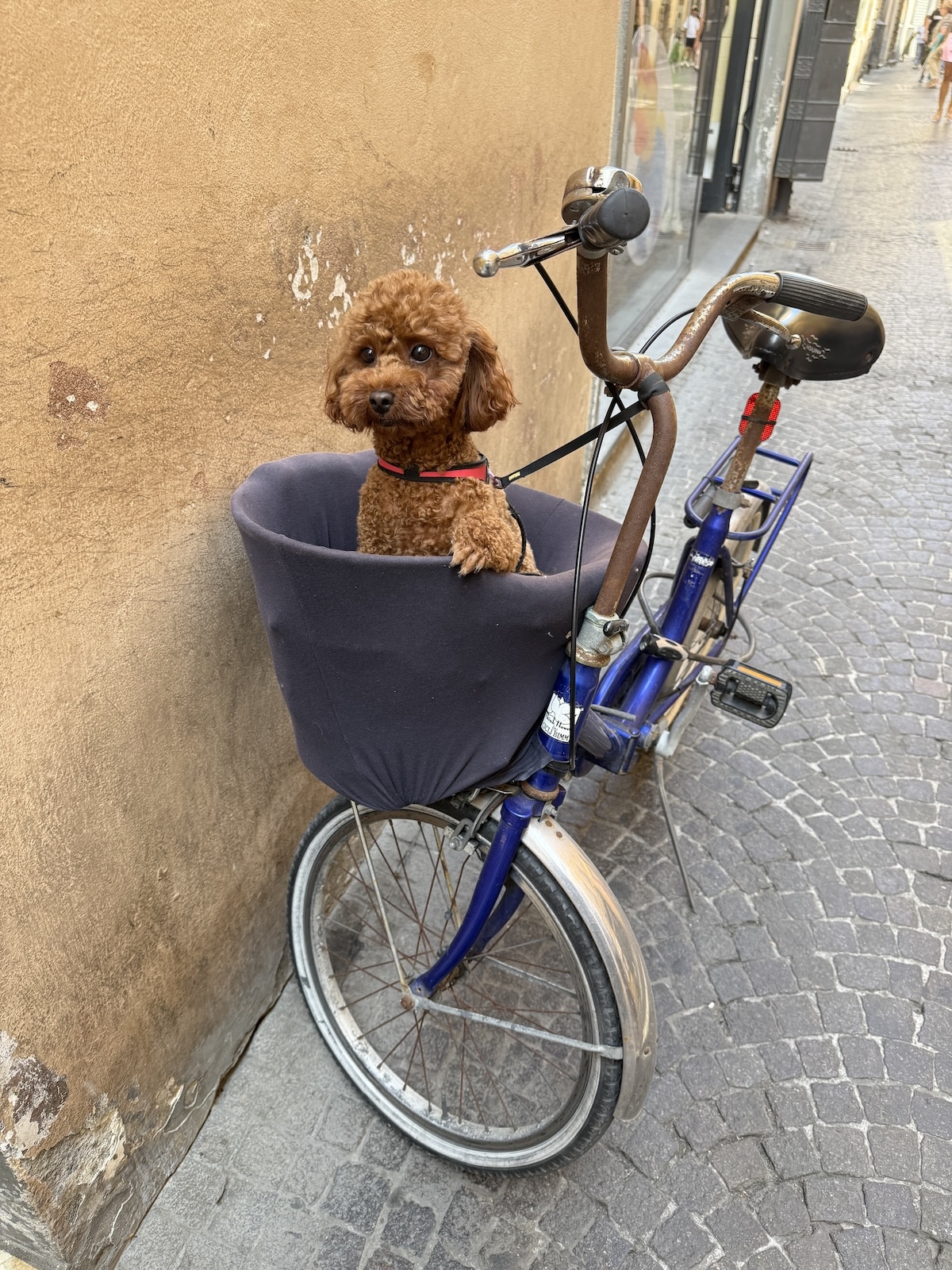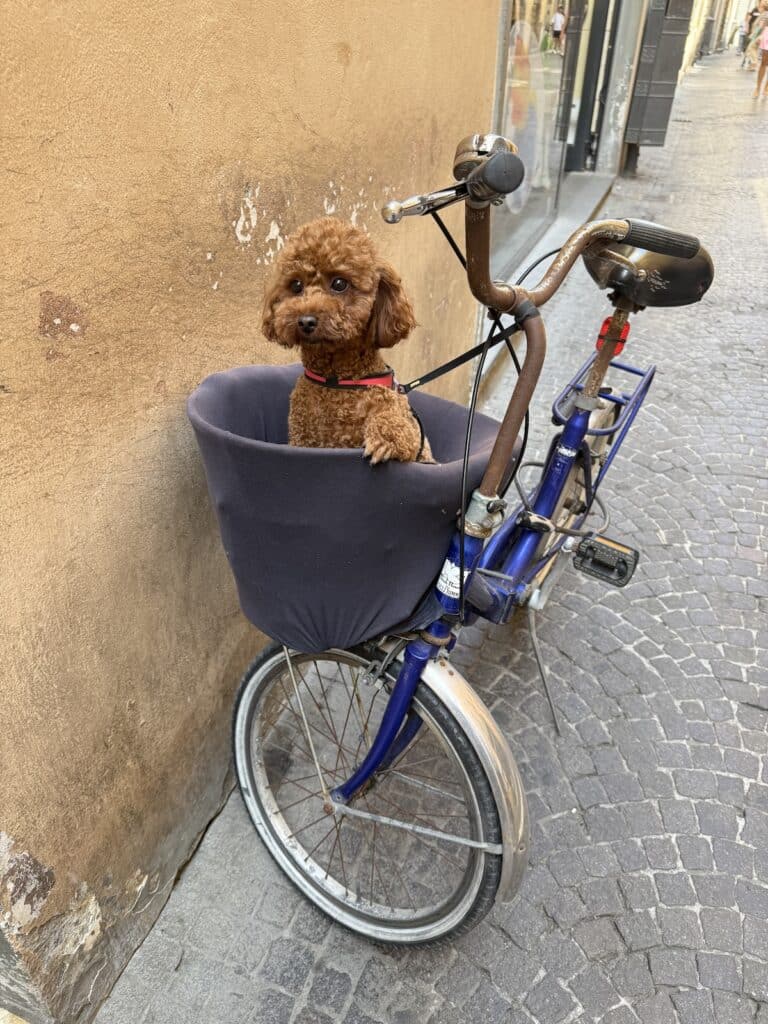
Flying from the U.S. to Italy with your dog in the cabin is equal parts thrilling and nerve-wracking.
The moment that tends to get travelers most? Standing at the ticketing counter with your dog tucked in the carrier, paperwork in hand, wondering if you’ve forgotten something crucial.
Pet travel isn’t straightforward, and international rules can get confusing fast. That’s exactly why I put this guide together.
I help clients plan month-long stays in Italy, and more and more travelers are choosing to bring their dogs along. This post focuses specifically on in-cabin pet travel from the U.S. to Italy.
A quick note on who this is for: only small dogs are currently allowed in the cabin on international flights. Your dog needs to fit comfortably in an airline-approved carrier that slides under the seat, so this guide is written with smaller breeds in mind.
So how hard is it to take a dog to Italy? Inside, you’ll find clear steps, airline realities, health requirements, and what to expect once you land. If you’re considering flying to Italy with your small dog in the cabin, this will give you the confidence to decide whether it’s the right choice for you and your pup.
The Airline Reality Check

Flying with a dog in the cabin to Italy means starting with one question: which airlines will even allow it. Not every carrier accepts pets on international routes, and many limit how many pets can be onboard.
Here’s what you need to know:
- Nonstop flights reduce stress. Connections add extra security screenings and more chances for issues.
- ITA Airways and Delta Airlines have the best options. They allow dogs up to 10 kg/20 lbs total (including the carrier).
- Each flight has limited pet slots. Booking early matters.
- Fees are usually in the $125–200 each‑way range.
Call the airline before booking your own ticket. You need to confirm there’s still space for your dog. Availability can change quickly.
Flat-Faced Dog Breed Warning
If you have a flat‑faced breed like a Pug, French bulldog, Shih Tzu, or Boston terrier, it’s important to know that these dogs are more vulnerable to breathing issues, overheating, and stress.
Many airlines have banned these breeds in cargo, but even in the cabin, you need to be careful.
A few things to think about:
- Schedule a vet visit to confirm your dog is safe for a long international flight. This is important for every dog, but it matters even more for flat‑faced breeds.
- Heat is harder on them.
- Altitude can make breathing more difficult.
- Sedation can be risky.
Documentation and Health Requirements
Paperwork is where most travelers get stuck. The rules can look complicated, but the steps are clear once you break them down.
Here’s what you need from the U.S. side:
- ISO microchip implanted before the rabies vaccine.
- Rabies vaccine at least 30 days before travel.
- USDA‑endorsed health certificate within 10 days of departure. Your vet will complete the form, but it must be endorsed by an official USDA office. Most travelers mail or overnight the paperwork to their state’s USDA APHIS Veterinary Services office, or visit in person if appointments are available. You can find your state’s office using the USDA APHIS locator.
- A vet certified by the USDA to issue the form.
Italy will check:
- Your U.S. health certificate.
- Microchip scan.
- Rabies documentation.
- Tapeworm treatment only applies to dogs coming from specific countries (not the U.S.).
Timeline:
- 6–8 weeks out: vet appointment.
- At least 30 days out: rabies shot if needed.
- 10 days out: USDA certificate.
- 1–5 days out: tapeworm treatment if applicable.
The biggest mistake is a missing a date or leaving a field blank. Double‑check everything.
Choosing the Right Carrier

The carrier matters more than people expect. It needs to fit under the seat and still give your dog enough room to lie down.
What to look for:
- Soft‑sided carrier (more flexible under seats).
- Lightweight (under 2 lbs).
- Good ventilation.
- Top or side loading.
- Airline‑approved dimensions.
Your dog should be able to stand and turn around comfortably.
I recommend testing the carrier at home for at least a week. Short sessions help dogs settle in before the flight.
Flight Day Strategy
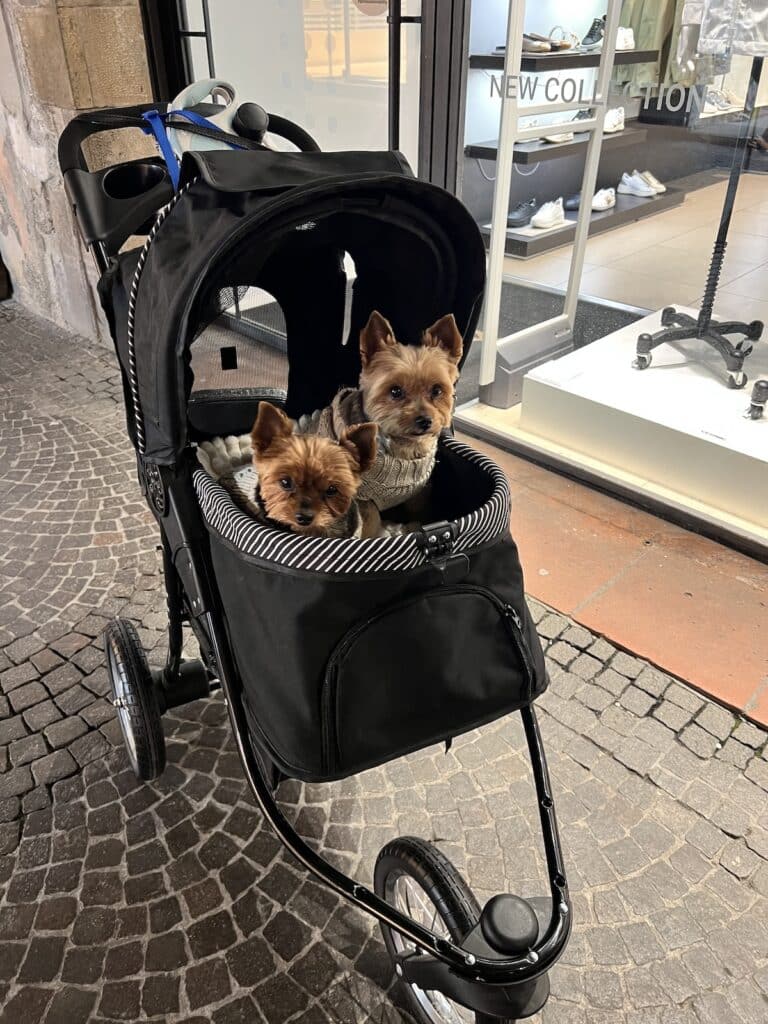
Travel day will feel smoother if you follow a simple routine.
Morning of the flight:
- Light meal or skip, depending on your dog’s vet advice.
- Water but not too much.
- Long walk to help them relax.
- Final bathroom break before heading inside.
At the airport:
- Arrive at least 3 hours early.
- Check in at the counter so they can verify your pet reservation.
- At security you’ll carry your dog through the scanner while the carrier goes through X‑ray.
- Most major airports now have pet relief areas.
On the plane:
- The carrier stays under the seat.
- You can unzip a small portion to offer water as long as your dog stays inside.
- Avoid feeding mid‑flight.
- Don’t sedate your dog.
Calming Strategies
Many dogs get anxious in new environments. A few gentle options help.
- Vet‑approved CBD.
- Calming chews.
- A shirt with your scent.
- Pheromone spray.
Always test any calming product at home first.
Avoid sedatives. They change how dogs breathe and regulate temperature.
Can I Take My Dog Out of The Carrier During The Flight?
In most cases, no. Airlines require dogs to remain fully inside their carrier for the entire flight, including international routes. The carrier must stay closed and stored under the seat in front of you.
A few important notes:
- You can usually slightly unzip the carrier to offer water or calm your dog, but the dog must stay fully inside.
- ITA Airways, Delta, United, and most major carriers have the same rule: pets cannot be taken out during the flight, even if they’re calm.
- The only exception applies to certified service dogs, which are allowed to stay at your feet in the cabin. Emotional support animals do not qualify.
- Flight attendants have the authority to tell you to re-secure the carrier if they feel the dog is not fully contained.
This is one of the strictest and most consistently enforced pet-travel rules, so it’s best to prepare for your dog to remain in the carrier the entire time.
Arrival in Italy
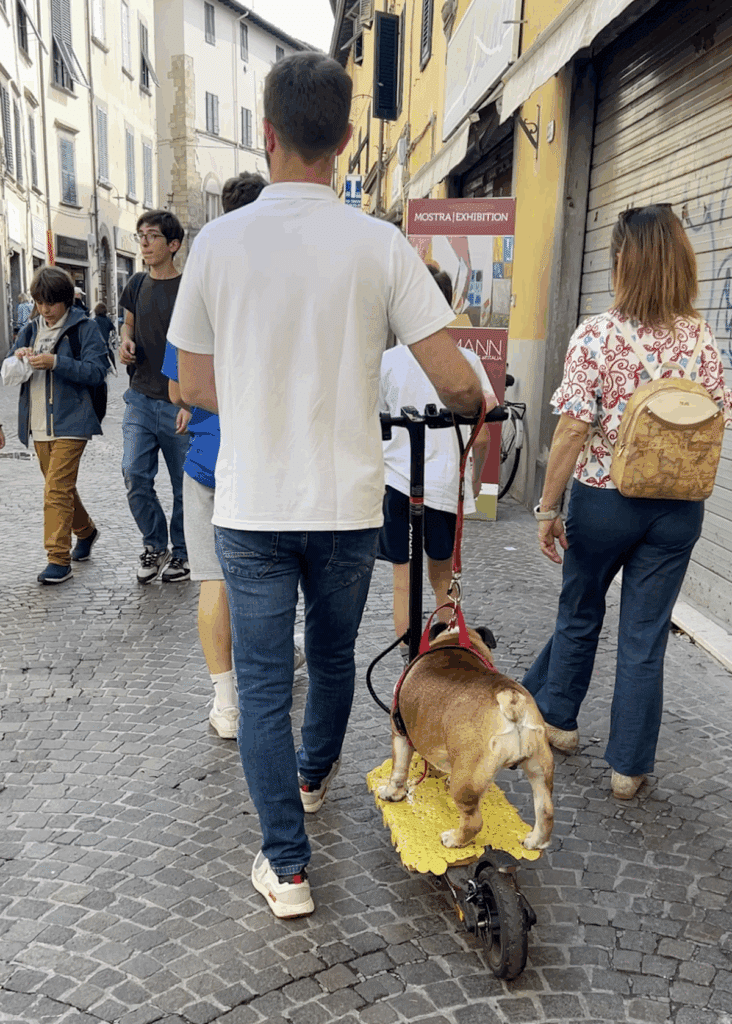
Once you land, follow the signs for passport control and baggage claim. You’ll keep your dog in the carrier until you exit the airport.
What to expect:
- A customs officer may ask to see your documents.
- The microchip may be scanned.
- Rome and Milan both have pet relief areas in the terminal.
Getting to your first stop:
Traveling with a dog means checking a few extra details so you know exactly what to expect when you leave the airport.
- Most taxis accept dogs, but confirm before loading your luggage. Some drivers may ask you to keep your dog in the carrier or place a towel on the seat. There’s no extra fee in most cases.
- Private drivers are usually pet‑friendly. When you book, mention that you’re traveling with a small dog in a carrier so they can choose the right vehicle. Most won’t charge extra, but asking ahead avoids surprises.
- Trains allow dogs, but they must be leashed and muzzled if they’re outside a carrier. Small dogs in carriers usually travel for free, and they do not need a muzzle because they remain secured inside the carrier. Dogs outside carriers require a muzzle and a ticket, which is typically a small fee added during purchase. Always check Trenitalia or Italo rules before your travel day. And no matter which option you choose, carry your dog’s documents with you at all times.
- Many travelers opt to rent their own car for the easiest and most flexible transport option with their pets.
Pet‑Friendly Stays in Italy
Most hotels and rentals will say they’re pet‑friendly, but rules vary.
Before booking, ask:
- Is there a size or weight limit?
- Are there extra fees?
- Are dogs allowed in common areas?
- Are there nearby green spaces?
If you’re using larger sites like Booking.com or Expedia, you can filter your search to show only pet‑friendly properties. This makes it much easier to sort hotels, apartments, and villa rentals without checking every listing manually. Still, it’s important to message the property directly to confirm their rules. Filters are helpful, but the details can vary. Many hosts welcome dogs, but some only allow them if they’re under a certain weight or stay inside a carrier in shared areas.
Local Etiquette and Rules

Dogs are welcome in many parts of Italian daily life.
You’ll see them at cafés, shops, and walking through historic streets.
A few things to know:
- Keep your dog leashed.
- Ask before entering indoor shops.
- Dogs aren’t allowed inside most museums.
Italy is a very dog‑friendly country, but the level of access can vary by region.
I live part‑time in Lucca, and it’s one of the most dog‑friendly cities I’ve ever experienced. You’ll see dogs everywhere — walking the walls, sitting under café tables, even relaxing beside their owners at restaurants.
It won’t look the same in every region, but don’t be surprised if places are more welcoming than you expect. Ask ahead, stay respectful of local norms, and you’ll usually get a clear answer.
Seasonal Considerations
Your travel month shapes how comfortable and safe the experience will be for your dog.
- Summer heat can be intense, especially in cities. Pavement gets hot, crowds are heavy, and flights are more prone to delays. Flat‑faced breeds struggle the most, but even healthy dogs can overheat quickly.
- Winter brings longer travel days and weather‑related delays. Keep extra food, wipes, and a backup pad in your personal bag in case you end up sitting on the tarmac.
- Shoulder seasons (April–early June and September–October) tend to be the easiest for dogs. Cooler temps and lighter crowds make the trip more manageable.
- Holidays are busy. Pet spaces on flights fill fast, and delays are common. If you’re traveling with your dog in December or during summer high season, book earlier than you think.
Should You Bring Your Dog?
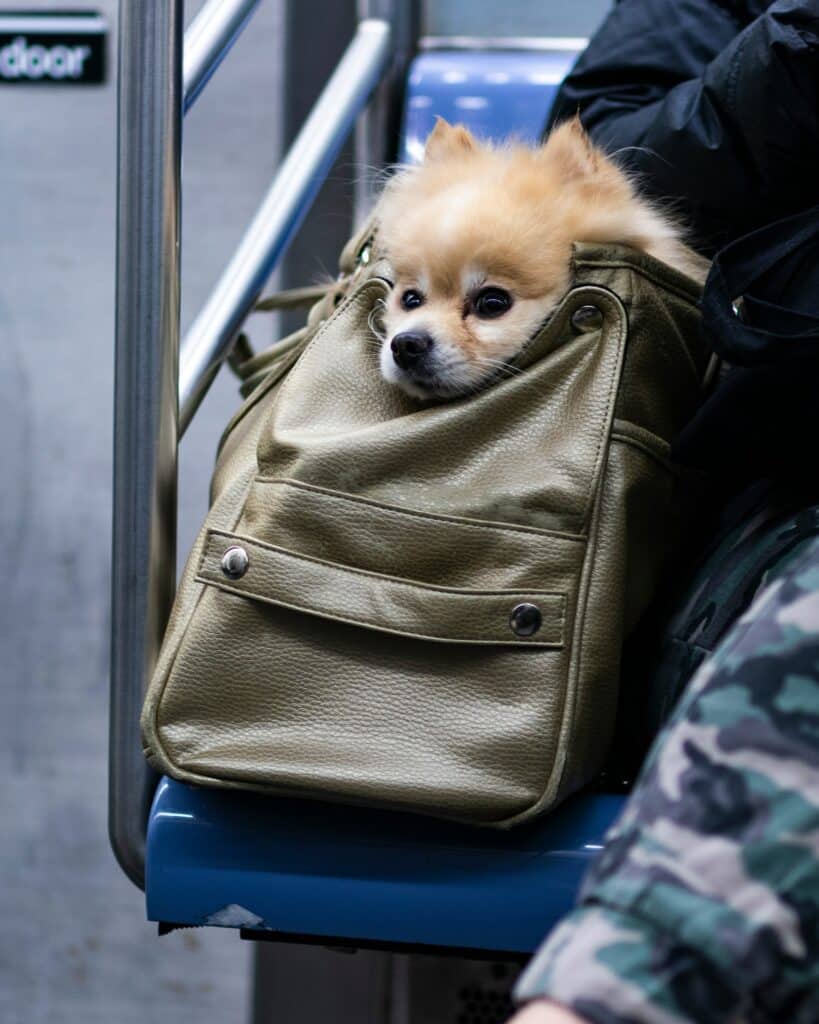
A few honest questions help you decide:
- Does your dog handle carriers without stress? Can they relax in enclosed spaces?
- Do they bark, whine, or panic in new environments?
- Can you adjust your itinerary to include breaks, shorter days, and downtime?
- Are you prepared for slower meals, limited museum entry, and more outdoor‑focused experiences?
Think about the rhythm of your trip. Visiting small towns, renting a car, staying in agriturismos, or spending time in nature works well for dogs. Fast‑paced itineraries with lots of cities, trains, and indoor attractions are harder.
Some dogs love being part of everything and settle quickly. Others feel overwhelmed the moment routine disappears. Trust what you know about your dog when making the call.
Packing List
A simple list helps keep things easy.
- Collapsible bowl
- Extra leash
- Wipes
- Pee pads
- Muzzle
- Food in sealed bags
- Travel first‑aid
- Familiar blanket
If Something Goes Wrong
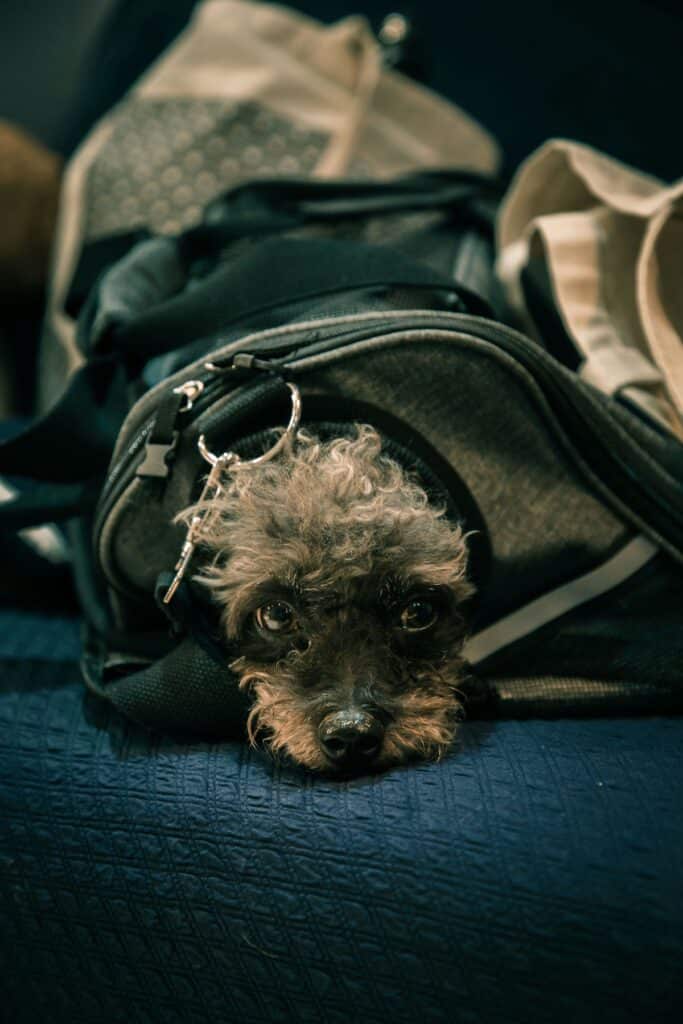
If your dog becomes ill during your trip, you’ll want to get help quickly and know exactly where to go.
Here’s what to do:
- Look for the nearest veterinario (veterinarian). Most towns and cities have several, and many speak some English.
- For urgent situations, search for clinica veterinaria emergenza or pronto soccorso veterinario. These are emergency clinics.
- Ask your hotel, host, or driver for help. Locals usually know which vet is open and trustworthy.
- Bring your dog’s documents with you: microchip info, health booklet, vaccine records, and your U.S. health certificate.
- If your dog needs medication, vets in Italy can usually dispense it on-site or direct you to the nearest pharmacy.
- Costs are generally lower than in the U.S., but ask for an estimate before treatment if it’s not an emergency.
Keep the clinic’s address and phone number saved on your phone before you go. Knowing where to go ahead of time brings peace of mind.
How Much Does It Cost To Bring Your Dog To Italy?
Expect to spend:
- Airline fee: $125–200 each way.
- Vet visit + certificate: $150–300.
- Carrier: $40–100.
- Calming supplies: $20–40.
Total: usually $500–800 round trip.
Flying With a Certified Service Dog
If your dog is a certified service animal, the rules are different.
Here’s what to know:
- Larger service dogs are allowed to fly in the cabin on most airlines, including international flights.
- The dog must be trained to perform a specific task for a person with a disability.
- Emotional support animals do not qualify as service animals for international flights.
- Airlines may require forms confirming the dog’s training and behavior.
- The dog must remain under control at all times—usually on a leash at your feet.
For example, a traveler who is blind or low-vision can bring a trained guide dog, even if the dog is larger than the standard cabin pet size.
Things to expect:
- Airlines will not charge a pet fee for a certified service dog.
- You must notify the airline in advance and submit required forms.
- The dog must fit safely in your foot space.
- Some airlines limit service dogs to one per passenger.
Ask your airline specifically for their international service dog policy, as documentation requirements vary.
FAQ
Can my dog fly in the cabin to Italy from the U.S.?
Only small dogs that meet airline weight and carrier requirements can fly in the cabin. Larger dogs must fly as cargo unless they are certified service animals.
What paperwork do I need to bring my dog to Italy?
You need an ISO microchip, rabies vaccine, and a USDA-endorsed EU health certificate.
How far in advance should I prepare?
Start 6–8 weeks ahead. The USDA endorsement must be done within 10 days of departure.
What airlines allow flying with dogs to Italy?
ITA Airways, Delta, and United allow in-cabin dogs on select routes. Always confirm directly with the airline because pet slots are limited.
What are the pet travel requirements for flying with a dog from the U.S. to Italy?
Your dog needs an ISO microchip, valid rabies vaccination, and a USDA-endorsed EU health certificate.
Which dog carriers are airline-approved for international flights to Italy?
Most airlines accept soft-sided carriers that fit fully under the seat. Check your specific airline’s size restrictions before buying one.
How do I book a flight ticket for a dog traveling to Italy?
Book your own ticket first, then call the airline immediately to reserve a pet spot. This must be done by phone because pet availability isn’t shown online.
What are the quarantine rules for dogs arriving in Italy by air?
Dogs from the U.S. do not face quarantine as long as their documents are correct and the microchip/rabies rules are followed.
Which airports in Italy have pet relief areas for arriving dogs?
Rome Fiumicino and Milan Malpensa both have designated pet relief areas after arrival.
Can I bring my large dog to Italy?
Large dogs cannot fly in the cabin unless they are trained, certified service animals. Otherwise, they must travel as cargo following airline-specific rules.
Can I buy a separate seat for my dog on a flight to Italy?
No. Airlines do not allow passengers to purchase a separate seat for a pet, even on international flights. Dogs flying in the cabin must stay inside an approved carrier that fits under the seat in front of you. The only animals allowed outside a carrier are certified service dogs.
I read online that all dogs can fly in the cabin to Italy. Is that true?
No. Some online articles claim Italy “allows all dogs to fly in the cabin,” but this is incorrect. Italy only regulates entry requirements (microchip, rabies vaccine, and health certificate). Airlines—not the Italian government—decide whether pets can fly in the cabin. Only small dogs that fit in an under‑seat carrier are allowed in the cabin on flights to Italy. Medium and large dogs must travel in cargo unless they are certified service animals.
Can I find a dog sitter in Italy? Yes. Platforms like PetBacker and TrustedHousesitters offer dog boarding, pet sitting, and day care in cities across Italy. TrustedHousesitters allows you to connect with local sitters wherever you are, so you can find someone nearby if you need help during part of your trip.
Conclusion
Flying to Italy with your small dog in the cabin takes planning, but it’s far less overwhelming once you understand the process. Here are the most important things to know:
- Only small dogs that fit in an airline‑approved under‑seat carrier can fly in the cabin.
- The paperwork matters. The ISO microchip, rabies timing, and USDA endorsement are non‑negotiable.
- You must reserve your dog’s spot with the airline. Pet spaces are limited.
- Your travel day will feel smoother if your dog is already comfortable in the carrier.
- Italy is a dog‑friendly country, but rules vary by region—so be ready to ask politely.
If you’re still deciding whether to bring your dog, think about your travel style, your dog’s temperament, and how much structure you’re willing to build into your days. Some dogs thrive on being part of everything. Others do better staying home.

